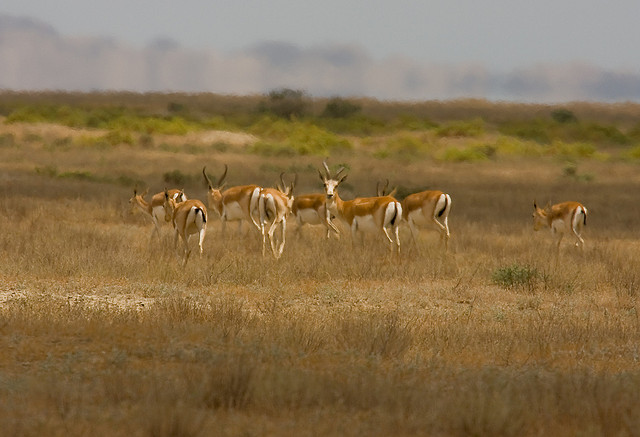Shirvan National Park, a look at nature

By Sabina Idayatova
One of the unique and interesting places in Azerbaijani nature, Shirvan National Park, encompasses an area of 54,373 hectares (543,735 km2) of Baku's Garadagh district, Salyan and Neftchala regions. Water reservoirs occupy about 4,000 hectares of the park, and most of the park has semi-desert landscape.
The entrance to Shirvan National Park is located on the Baku-Alat-Astara highway, approximately 100 km south of the capital Baku. The park, which is about 20 to 27 meters below sea level, is located in flat semi-deserts interrupted only by a few artificial channels, a semi-artificial lake and a few mud volcanoes. Hot and dry summers and cool and dry winters are observed in the park's area. The diversity of the terrain, vegetation and soil cover allow to distinguish a number of natural landscapes.
The reserve's activity is focused on the protection and population of the remaining Goitered gazelles listed in the Red Book of Azerbaijan and to preserve an important part of the nation's natural heritage, the semi-desert of the Kur-Araz lowlands.
A major part of the park is occupied by small saline semi-desert hills and a saline semi-desert plain. A chain of hills is the main terrain that shaped as a result of the wind and serves as an excellent shelter for gazelles. Azerbaijan`s territory is considered to be the main habitat of gazelles. However, in the last 50-60 years expansion of anthropogenic activity has devastated their environmental balance and posed a threat to them.
Besides gazelles, other mammals such as foxes, jackals, hares and wolves, wild and jungle cats, lizards, snakes, badgers, beavers, jerboas, long-eared hedgehogs, bats, and turtles may be encountered at the park.
The national park has an extremely rich ornithological fauna. Rare and valuable species of birds such as bustard, swan, flamingo, etc. spend the winter and nest in the marshy areas of the park.
Furthermore, there are several types of vegetation. Halocnemum vegetation occupies about 40 percent of the territory of the park. The main species is Halocnemum strobilaceum. The slopes are covered by cereals and motley grass. The semi-desert type of vegetation is represented by formations of sveda and ephemeral wormwood. Meadow-type vegetation is developed in the park on humid lowlands.
The largest wetland in Shirvan National Park, the Flamingo Lake and adjacent reeds are of anthropogenic or semi-artificial origin. However, they play an important role, especially as places of rest for waterfowls and other migrating birds. Despite its artificial origin, the lake complements the nature of Shivan National Park.
The morphology of Flamingo (Gizilgaz) Lake is similar to that of other steppe lakes in Azerbaijan. The lakeside is shallow and often not well demarked due to changing water levels. The depth rarely exceeds 1 m. On average, the depth is 0.5 m. The entire bottom of the lake is overgrown by submerged plants which are the food base for resting and wintering waterfowl. In the case of Flamingo Lake the water level is influenced by precipitation, evaporation and the flow of brackish water by means of irregular pumping. In general, the water level follows the pattern of a typical steppe lake: a high water level in winter and a low one in summer. Some 12 fish species live in the Flamingo Lake and canals.
Moreover, mud volcanoes imprint the scenery of Shirvan National Park. There are three mud volcanoes in the Shirvan National Park, which are rich in terms of their high bulging craters.The difference of mud volcanoes in the area are their excretion of liquid mud and oil instead of fiery lava. The mud is pressed to the surface by gases like methane or hydrogen sulphide. While the semi-desert is characterized by a scattered vegetation cover, the mud volcanoes are almost free of vegetation. Bandovan Mountain is the most famous mud volcano in the park.
Very simple accommodation is available upon request in the Shirvan National Park. But be aware that driving there is almost impossible after rain.
Camping is possible around the bungalows and at the Lake House. A beach which is situated outside the park's northern boundary is also a nice place for camping. But be aware that there isn't any infrastructure out there. After rainfall it might become difficult to drive back through the steppe.
While visiting the national park you need to ensure that you do not disturb plants, animals, special sites or the enjoyment of other visitors. Waste causes damage to the environment and endangers animals.
Vehicles must stay on marked tracks or roads as they may cause damage to plants and animals or disturb them. Keep your pets under control in order not to scare or kill animals. It is not allowed to hunt, to fish or collect plants and plant material.
You need a special permission for camping overnight, to make
photos or films for professional purpose, for scientific studies.
According to weather conditions one should bring warm clothing and
wind protection. Put on sunscreen and a hat.
Be aware of your steps during the warm season as the park is home
to poisonous snakes. Avoid stepping in the bushes.
Swimming in the Caspian Sea is at your own risk. Be aware of the
general dangers of swimming in open water. The beaches along the
coast of Shirvan National Park are not under lifeguard
supervision.
The park also targets conduct of scientific research and environmental monitoring, as well as creating conditions for tourism and recreation.
Here we are to serve you with news right now. It does not cost much, but worth your attention.
Choose to support open, independent, quality journalism and subscribe on a monthly basis.
By subscribing to our online newspaper, you can have full digital access to all news, analysis, and much more.
You can also follow AzerNEWS on Twitter @AzerNewsAz or Facebook @AzerNewsNewspaper
Thank you!
